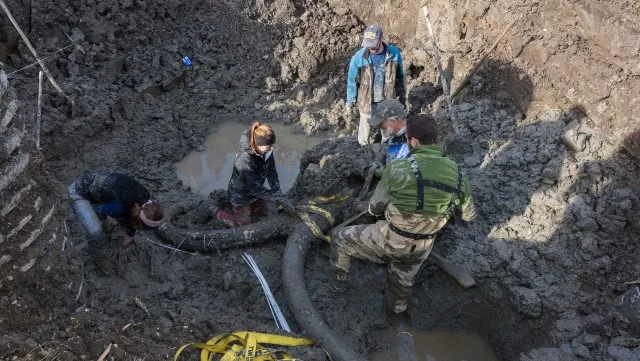Farmers stumble across mammoth skeleton in their soybean field

Farmers from Michigan accidently dug up a skeleton of a mammoth in their soybean field last Monday. By Thursday, 15 paleontologists had jumped onto the scene and discovered the mammoth was likely to have been hunted, butchered into prehistoric steaks and stored by humans somewhere between 10,000 and 15,000 years ago.
Farmer James Bristle and his friend were digging in his field to make way for a natural gas pipeline, when suddenly they struck something. Speaking to Ann Arbor , Bristle said: “We thought it was a bent fence post.” On further inspection, it turned out to be a 2 foot (60 centimeter) rib bone.
After alerting the University of Michigan to their find, a team headed by the institution's Professor Dan Fisher made their way to the site and began excavating. A remarkable discovery, Fisher told Detroit Free Press that it was "one of the more complete sets of woolly mammoth bones ever to be found in the state." Although Michigan is no stranger to finding these kind of things; the remains of around 300 mastodon and 30 mammoth have been found in the midwestern state to date.
Fisher also added that the beast was unlikely to be a woolly mammoth, but actually a hybrid between a woolly mammoth and Columbian mammoth - a species even larger that its hairy cousin, capable of growing up to 4 meters (13 feet).
So far, the team has found the mammoth’s skull, pelvis, both tusks, both shoulder blades and numerous vertebrae and ribs. However, the bones that are lost are almost as interesting as the ones found. It is missing its hind legs and feet, suggesting that the mammoth had been partially eaten by humans. Furthermore, three basketball-sized rocks were found around the carcass, which experts think could have possibly been used as an anchor to weigh the animal down in a pond, possibly for later preservation in a kind of Flintstone-esque refrigerator.
Among the bones, three basketball size rocks have been found surrounding the mammoth, which it is thought were used to anchor the carcass in the pond. The discovery gives a great insight into when humans first arrived in the Americas and how they behaved around this time, especially their culinary expertise.
Tags:





